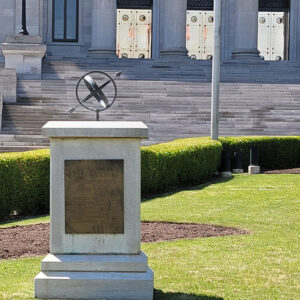calsfoundation@cals.org
Kelly Bryant (1908–1975)
Kelly Bryant was a Democratic politician in the 1960s and 1970s. He has long been identified as the first of three Hope (Hempstead County) natives who won statewide office from the 1960s to the 1990s, heading a trio that also included Bill Clinton and Mike Huckabee.
Kelly Bryant, who grew up in Hope, was born in Shawnee, Oklahoma, on August 8, 1908, to Charles C. Bryant and Anna May Nelson Bryant. The family moved to Hope soon after Bryant’s birth. After finishing high school, Bryant attended the University of Arkansas (UA) in Fayetteville (Washington County), graduating in 1934 with a degree in business administration.
Bryant spent the bulk of his professional life working in journalism and publishing before entering public service. He was the editor and publisher of the daily Hope Journal from 1939 to 1951, and he also served as the publisher of the Arkansas Almanac. While serving as the field secretary for the Arkansas Sheriffs Association, he edited the organization’s official magazine. That association would later become important when he ran for office, giving him a strong base of support with sheriffs in the state. A longtime member of the Arkansas Press Association, Bryant was the state printing clerk for over two years while also serving on the staff of the state auditor.
Bryant was elected secretary of state in 1962, serving from 1963 until his death. Over the course of his career, he was actively involved the National Association of Secretaries of State and served in a number of different positions before his service culminated with a term as president in 1971.
Over the course of seven elections, Bryant showed himself to be highly accomplished at getting votes. He initially secured the 1962 Democratic nomination to succeed the retiring Nancy J. Hall; she had been appointed to complete the term to which her late husband, C. G. “Crip” Hall, who had served for almost a quarter century, had been elected. Running unopposed in the 1962 general election, Bryant won the first of his seven two-year terms. After Hall, Bryant represented a new, if not necessarily progressive, wave of office holder. Indeed, a subsequent opponent would charge that Bryant was little more than an old-school politician whose prowess was based in the strong support he received from the sheriffs who held sway in the state’s rural areas. Indeed, whatever the source, Bryant quickly emerged as a popular official. He ran unopposed in the general elections in 1966 and 1974; his victory in 1968, when he won with just under fifty-five percent of the vote, represented the only time that his margin of victory was less than fifteen percent.
As secretary of state, Bryant was known as a low-key overseer of the state’s operations. With responsibilities that included maintenance and supervision of the Arkansas State Capitol, he was seen as a man who avoided the spotlight and simply kept the wheels of government moving, though he was also known as a happy guide for student groups. As head of the Election Division, he oversaw all voting related issues. Bryant was in the middle of his seventh term and planning a reelection bid in 1976 at the time of his death.
Bryant’s tenure was not without its share of controversies. As overseer of the capitol and its offices, in 1975, he found himself in the midst of the unprecedented interim governorship of Bob Riley, a brief eleven days during the period between Dale Bumpers’s assumption of his U.S. Senate seat but before his successor David Pryor was inaugurated. Bryant served as something of a referee on issues ranging from offices for new appointees—if such appointments could be made—to the proper placement of the portrait of the interim governor, to ordering stationery to be used during his time in office. In another curious if ultimately embarrassing incident during the Bryant years, Bryant, in an effort to polish the statuary on the capitol grounds, had cleanser applied to the works scattered around the grounds. Unfortunately, the process removed decades of the desirable patina that distinguished the statues.
Bryant’s opponents alleged scandals of varying degrees, from putting his wife on the payroll, to his handling of the American Party’s petitions to get on the ballot, to a fatality in a capitol fire. There were also allegations of impropriety, if not corruption, in the awarding of state printing contracts, with one company, International Graphics, suing the secretary of state and his office, alleging that they had been denied a low-bid victory. While in this case the company’s initial victory was overturned on appeal and the secretary of state’s office exonerated, the incident cast a less than complimentary light on the office and fueled long-time concerns about its contract-awarding operations. There were also allegations of mismanaged corporate records. Bryant also infamously organized a testimonial dinner for himself, which he had to cancel when the Arkansas Gazette reported his role in organizing the affair. Yet none of it threatened his hold on the office.
In the middle of his seventh term, while battling ongoing health problems, Bryant died on October 30, 1975. Bryant and his wife, Elizabeth Sutton Bryant, with whom he had a daughter, are both interred in Memory Gardens Cemetery south of Hope.
Bryant’s years as secretary of state represented the second-longest tenure in the office in Arkansas history, exceeded only by Crip Hall, and both men have had their service recognized with markers on the grounds of the state capitol.
For additional information:
“Arkansas Secretary of State Dies.” Courier News (Blytheville, Arkansas), October 31, 1975, pp. 1, 12.
Durning, Dan. “The Climer Campaign: The Crusade Nobody Noticed.” Arkansas Advocate 1 (July 1973). Online at https://www.scribd.com/document/110446291/The-Climer-Campaign-The-Crusade-Nobody-Noticed (accessed June 5, 2021).
“Secretary of State Dies of Cancer at 67; Was Serving His 7th Term.” Arkansas Gazette, October 31, 1975, pp. 1A, 3A.
William H. Pruden
Ravenscroft School
 Mass Media
Mass Media Politics and Government
Politics and Government World War II through the Faubus Era, 1941 through 1967
World War II through the Faubus Era, 1941 through 1967 Bryant Plaque at Capitol
Bryant Plaque at Capitol  Kelly Bryant
Kelly Bryant 




Comments
No comments on this entry yet.